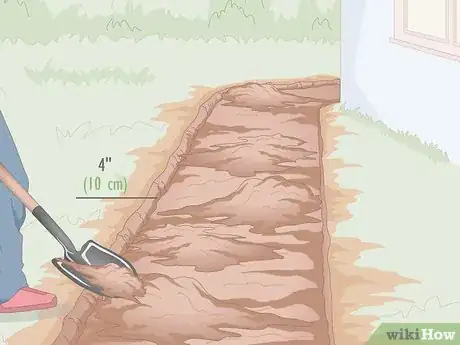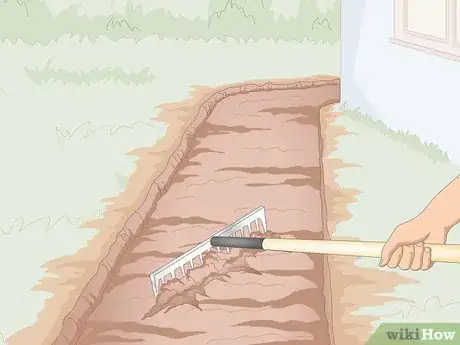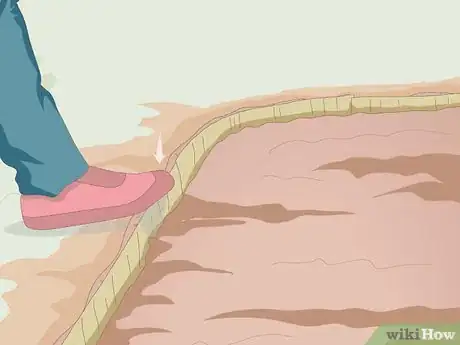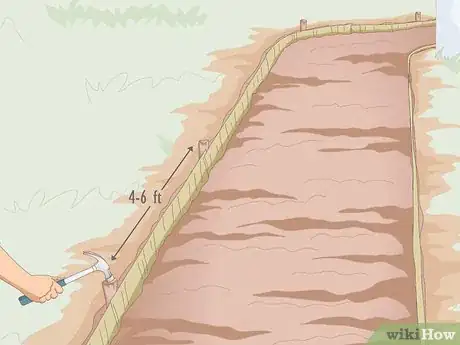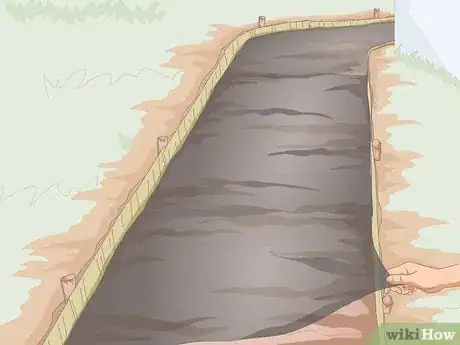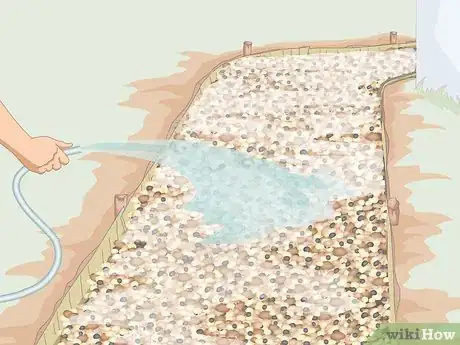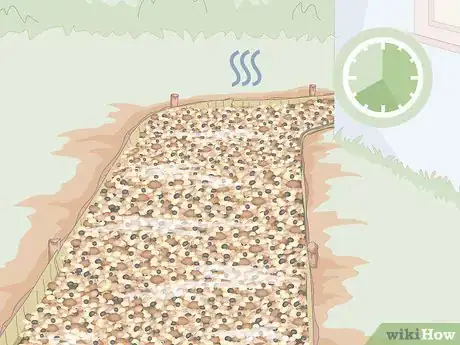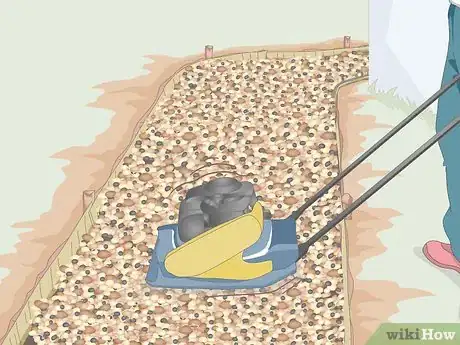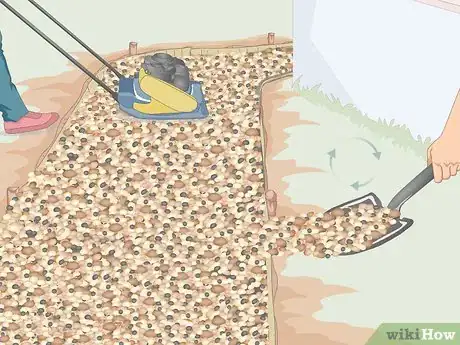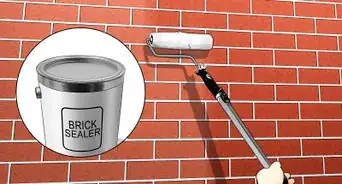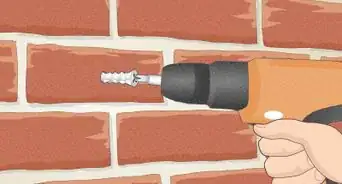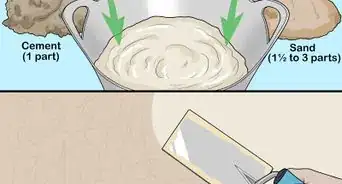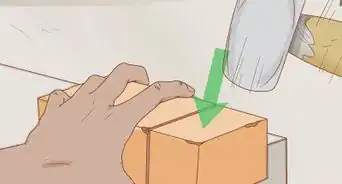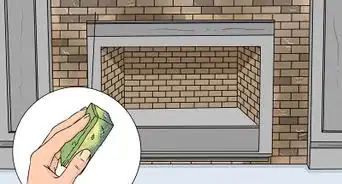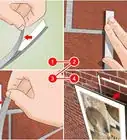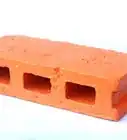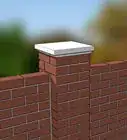This article was co-authored by wikiHow Staff. Our trained team of editors and researchers validate articles for accuracy and comprehensiveness. wikiHow's Content Management Team carefully monitors the work from our editorial staff to ensure that each article is backed by trusted research and meets our high quality standards.
There are 11 references cited in this article, which can be found at the bottom of the page.
This article has been viewed 55,129 times.
Learn more...
Decomposed granite is a type of surfacing material made up of crushed rock. Since it is firm and water-resistant, it is often installed as a natural alternative to material like pavement. It also happens to be relatively easy to install on your own even if you don’t have much construction experience. A successful installation depends on excavating and flattening a well-drained spot. After surrounding the area with edging to hold the granite in place, fill in the hole and smooth out the material to create a level finish. The finished surface is great for gardens, driveways, patios, and many other projects.
Steps
Excavating the Ground
-
1Choose a relatively flat area away from water drainage for protection. Decomposed granite can be washed away by flowing water, so choosing flat ground makes it last longer. For example, don’t place it near the bottom of a hill, since water will flow down toward it. When you see areas that aren’t level, dig out excess soil and rake the ground flat. Also, be aware of any utility lines that could be in the area and call your local utility company to mark their location so you don't accidentally damage them.[1]
- You may need to level out some parts of your yard in order to install the granite. For example, if you’re planning on building in a recessed area, excavate nearby raised areas as well to prevent runoff from flowing toward the granite.
- You may need to work around utility lines unless you’re willing to pay to move them, which can cost $300 USD or more.
- Keep the granite away from your home's foundation, especially if the roof doesn’t have gutters. Rain will roll off the roof and onto the granite, ruining it.
-
2Outline the construction area using chalk or another tool. Mark the spot you plan on excavating for the installation. Doing this will help you plan out the work so the granite layer is consistent and even on all sides. The easiest way to create the outline is by using chalk spray paint. Make the outline as accurate as possible, taking time to measure the lines as needed to ensure they are the correct length for what you plan on building.[2]
- Getting the outline correct is important since the construction work could cause problems later if it is done incorrectly. Note the outline’s location and dimensions to ensure that the granite will fit where you intend on placing it.
- All of the tools you need for the installation, including chalk and granite, are available online and at most home improvement stores.
Advertisement -
3Dig down at least 4 in (10 cm) to create space for the granite. The exact depth will depend on the project, but a 4 in (10 cm) layer of granite is enough for most areas that will receive heavy traffic. Use shovels to remove soil from the excavation area. This will be where you pour the granite later, so make sure it is cleared out sufficiently. If you don’t dig deeply enough, the granite layer could end up being shallow or uneven.[3]
- A 4 in (10 cm) depth is a good starting point for most pathways. For patios, driveways, and other areas that experience heavy foot traffic, try installing a 6 in (15 cm) for extra durability.
- If the soil is soft or sandy, plan on installing a thicker layer of granite. Try making excavating 6 in (15 cm) or deeper.
- You can always dig deeper to fit more granite. It increases the cost of the project, but the thicker layer helps ensure the granite lasts longer.
-
4Level out the ground by raking and compacting it. Dig up any rocks, tree roots, and other debris left in the hole. Once the area is clear, rake the soil to finish flattening it. Then, use a tool like a plate compactor to compress it. To use a compactor, turn it on and push it over the soil several times. The soil has to be consistent so the granite doesn’t shift after the installation.[4]
- If you don’t have a compacting tool, check with your local home improvement store. Some places rent out mechanical plate compactors.
- You could also use a handheld tamper, which is a square tool you can push against tough to reach areas to flatten them. For a more makeshift option, lay down a wood board and hammer it to flatten the soil.
Framing the Construction Area
-
1Place header boards around the edge of the excavation area. Header boards are basically boundaries meant to keep the granite packed into the hole you dug. The most common type of edging material is called redwood bender boards. The boards are flexible, making them useful for framing even curved granite paths. Bend the boards by hand, pressing them into the soil to place them. Overlap each board by about 1 in (2.5 cm) so it can expand with the weather.[5]
- There are several different types of edging you can use for your project. Metal is a sturdy alternative to wood that works well for almost any project. Plastic is also useful, especially around gardens.
-
2Place stakes about every 4 to 6 ft (1.2 to 1.8 m) around the boards. Choose 12 in (30 cm) wood stakes if you’re using wood bender boards. Start at one end of your project and measure out from there, planting stakes as you go. Put the stakes on alternating sides, keeping them right up next to the boards. Plant them by hammering them down into the soil until they are 1 in (2.5 cm) below the tops of the boards, then secure them to the boards with screws or nails.[6]
- Secure each stake with a single screw or nail. Position the fastener against the middle part of the stake on its outer edge. When you secure everything together, the fastener will pass through the stake and into the header boards.
- Metal headers often have slots for metal stakes, so you don’t need to screw them in place. Plastic edging material often does not require stakes.
- When you’re done installing the stakes, you can hammer the boards down until they are level with the ground if you wish to hide them.
-
3Spread a weed barrier over the soil if you wish to protect it from weeds. If you suspect that weeds will be an issue, get a roll of weed barrier fabric and some galvanized garden staples. Roll the fabric out so it covers the area you excavated. Place the staples about every 1 ft (0.30 m) along the edges of the fabric. Then, hammer them through the fabric to secure it to the ground.[7]
- You may need to cut the fabric to fit it into the hole, especially if you’re making a curved path. Use a utility knife to cut it to size.
- Installing a weed barrier is optional, although it often works well for garden areas and paths.
- A weed barrier is meant to stop weeds from growing underneath the fabric. Over time, weeds may eventually settle on top of it. The fabric can also prevent water from draining through the granite as quickly as it usually does.
Adding the Granite
-
1Calculate how much granite you will need for the project. Measure the length, width, and depth of the hole you dug in feet. If it is uneven, such as for a path, measure its entire length, then measure the width where the path is widest. Multiply all 3 measurements together to determine the overall size of the hole. Decomposed granite is often sold by the cubic yard, so divide the size measurement by 27, the number of cubic yards in a cubic foot, to determine how much granite you need.[8]
- For example, a hole 20 ft long, 10 ft wide, and 4 in deep is about 66 cubic feet. Divide 66 by 27 to convert it into about 2.47 cubic yards of stone.
- For additional help, look up a coverage calculator for decomposed granite or stone. Type the hole dimensions into the calculator to determine how much granite you need to buy.
-
2Choose stabilized granite to get a sturdy material suitable for most projects. It is pre-treated with a stabilizer that causes it to stick together, making it very effective for pathways and patios. It is also efficient to install. If you get regular granite, you could also treat it with a liquid stabilizer to get it to stick together. You can usually buy sacks of granite at home improvement stores and then pour the stones into the construction area yourself.[9]
- Regular, or natural, decomposed granite, is the least expensive type and is very porous. It works well as a mulch around gardens or other areas that require efficient water drainage.
- Resin decomposed granite is treated for extra stability and durability. Since it’s similar to asphalt, it’s useful for areas that experience a lot of heavy traffic, like roads or driveways.
-
3Spread the granite out in a layer up to 1.5 in (3.8 cm) thick. Scatter the granite by hand, with shovels, or with a wheelbarrow. Make sure it is roughly the same depth throughout the hole. If you’re uncertain about the layer’s thickness, measure it with a ruler or tape before filling in the entire area. When you’re done, smooth out the granite with a steel rake or shovel.[10]
- The exact depth of the layer isn’t as important as its consistency. If it isn’t level now, the finished project may not turn out the way you envisioned.
- Decomposed granite surfaces are layered, so don’t fill in the hole all at once. The layers adhere to one another, making the surface stronger. It also gives you more of an opportunity to keep the granite compact and level.
-
4Soak the granite thoroughly in water. Hook a garden hose up to a nearby water source, then spray all of the granite. Make sure you use enough water to reach the stones at the bottom of the layer. The entire layer will turn muddy and sticky as it absorbs water.[11]
- One way to check for water absorption is to stick a metal pole through the granite. Note the height of the mark left by the granite on the pole. It should be the same as the layer’s thickness.
-
5Wait 5 to 8 hours for the granite to dry out. It has to be completely dry before it can be built upon and covered by additional material. Wait for it to feel dry to the touch, but check the entire area to make sure there aren’t any hidden spots that haven’t finished settling yet. The required drying time may vary depending on the conditions and can take as long as 24 hours.[12]
- Cold, damp weather will prevent the granite from drying out as quickly as you would like. If you’re unsure, wait a full 24 hours to ensure it has plenty of time to dry out.
-
6Compact the granite using a plate compactor or another tool. Use a plate compactor for the easiest possible time finishing the gravel layer. It is a machine that rolls over the granite to solidify it into a firm, consistent layer. Go over the granite a few times to ensure it’s packed as tightly as possible. The granite layer loses about 1 in (2.5 cm) in height when it’s compacted, allowing you to build additional layers over it.[13]
- Most home improvement stores rent out compactors. Compactors are heavy, so you may need to bring a friend along to help you transport it.
- If you don’t have a compactor, get a heavy roller instead. It’s a heavy, wheel-like tool that you can roll over the granite by hand. A tamper tool can also be helpful, especially for areas you can't reach with a roller.
-
7Repeat layering and compacting the granite until the hole is filled. Add another layer of granite, soak it, and then compact it. Remember to smooth out each layer before adding water. You will also need to wait for each layer to dry before compacting it. Most projects require 3 layers, so keep adding more granite until you reach the desired height.[14]
- The wait is the longest part, but take your time. The sturdy, level surface you end up with is well worth the patience.
- Note that the finished height will vary depending on your design. In most projects, the decomposed granite will be level with the rest of your yard. If you’re making a patio, you may wish to elevate it a little more to prevent mulch or other material from spilling over onto it.
Things You’ll Need
- Decomposed granite
- Shovel or excavator
- Bending boards or other edging material
- Stakes for edging material
- Hose
- Water
- Plate compactor or roller
- Tamper tool
- Weed barrier fabric (optional)
- Weed barrier staples (optional)
References
- ↑ https://www.thisoldhouse.com/how-to/how-to-lay-budget-friendly-gravel-path
- ↑ https://www.bobvila.com/articles/3677-how-to-install-landscape-edging/
- ↑ https://www.thisoldhouse.com/how-to/how-to-lay-budget-friendly-gravel-path
- ↑ https://www.bobvila.com/articles/landscape-fabric/
- ↑ https://www.bobvila.com/articles/3677-how-to-install-landscape-edging/
- ↑ https://www.familyhandyman.com/landscaping/the-best-garden-bed-edging-tips/
- ↑ https://www.bobvila.com/articles/landscape-fabric/
- ↑ https://www.youtube.com/watch?v=Q1bdeS19kQU&t=42
- ↑ https://www.youtube.com/watch?v=Y1Z8UznTrRw&t=24


